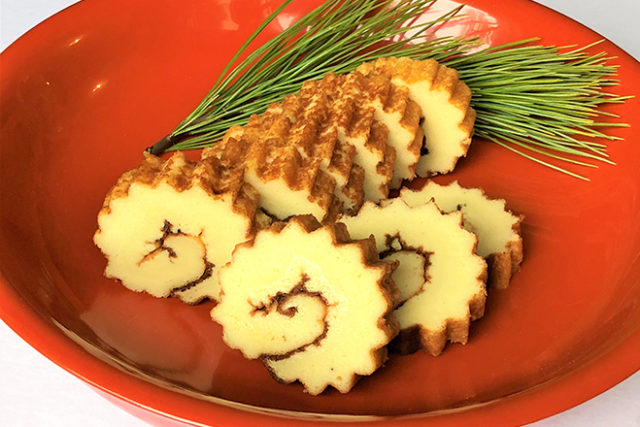Datemaki – Sweet Rolled Omelet
Serves 4-6 | Prep time 20 minutes | Cook time 25-30 minutes
What’s your favorite Osechi Ryori? Osechi Ryori are traditional Japanese New Year’s foods. You can buy assorted Osechi boxes from restaurants and grocery stores, or some dishes can be easily made at home, such as Namasu (daikon and carrot salad in sweet vinaigrette), Kuromame(sweet black soybeans) and Chikuzen-Ni. But most people still buy Nerimono (fish paste products) such as Kamaboko (a type of fish cake, often available in red and white for New Year’s celebration).
Datemaki (sweet rolled omelet with white fish paste called ‘surimi’) is also a type of Nerimono that is commonly available commercially. It was not my favorite osechi dish, because it was overly sweet for my taste. But that changed a few years ago, when I was invited to an Osechi potluck hosted by a friend of mine, at which everyone was asked to participate in making some osechi ryori. I decided to give a low-sugar, no-additive version of datemaki a try. It turned out it was much easier to make than I had thought. It has instantly become one my favorite Osechi since.
Ingredients and cooking steps are simple and straightforward. I used Hanpen (a type of soft fish cake) instead of surimi to make the recipe even easier and more economical. For the 2019 New Year, add this great homemade datemaki to your osechi repertoire for your family!
Ingredients
Dashi
- 3 inch sheet kombu
- ¼ cup bonito flakes
Datemaki
- 1 package Hanpen (3.5-3.8 oz.)
- 4 large eggs, beaten
- 3 Tbsp. dashi
- ½ Tbsp. Usukuchi (light-colored) soy sauce
- 4 Tbsp. sugar
- 1 Tbsp. mirin
Instructions
Make dashi
Boil 2 cups water in a medium sauce pan. Add chestnuts and cook for about 15 minutes. Strain and cool the chestnut to room temperature. Then peel the chestnuts using a pairing knife. Set aside.
Make dashi
- Put kombu and 2 cups of water in a medium saucepan and heat over medium-high heat.
- Once kombu is hydrated and water starts to boil, add bonito flakes and reduce heat to medium.
- Cook for a minute and remove from heat. Cool to room temperature and strain. Discard the kombu and bonito flakes. Set aside.
Make Datemaki
- Preheat oven to 390F (200C).
- Line an 8×8 square baking pan with parchment paper to cover the bottom and sides of the pan.
- Tear Hanpen by hand into small pieces and put them in a food processor or blender. Grind hanpen until smooth. Add eggs, dashi, soy sauce, sugar and mirin and process again for a few minutes.
- Pour the egg batter into the lined baking pan and put it on the middle rack in the oven. Bake for 25-30 minutes until the surface turns golden brown.
- While the omelet is hot, put a sushi mat with the flat side up on top of the omelet, and flip the mat and pan together, holding the mat with one hand wearing a glove. Remove the pan and parchment paper.
- Align the omelet with the bottom of the sushi mat. With a paring knife, score a few shallow lines along the bottom of the omelet, about an inch from the edge. Then roll up the omelet with the sushi mat tightly and secure the roll with a few rubber bands.
- Cool the omelet to room temperature then in the fridge for a few hours or longer. Remove the mat and cut the omelet crosswise into ½ inch slices.
Recipe by Kanako Koizumi | www. kozmokitchen.com
Kanako, a native of Akita, Japan, is a chef, author and instructor focused on authentic Japanese homecooking. Chef Kanako also offers in-home private cooking classes for groups up to 12. You can reach her at info@kozmokitchen.com.
HAPPY NEW YEAR !!
Kanako’s popular Nabe hands-on classes at PCC Cooks will start in February, this with
an addition of a new recipe “SUKIYAKI”!
Sign up now at https://www.pccmarkets.com/class/japanese-nabe-party/








